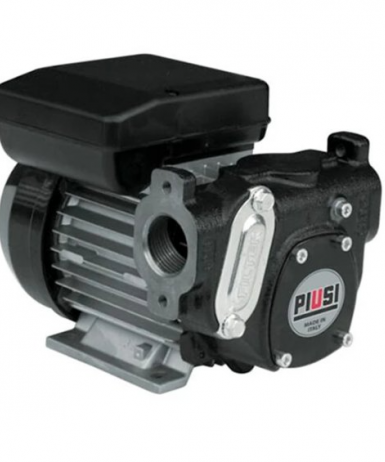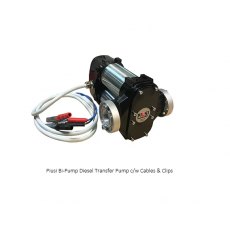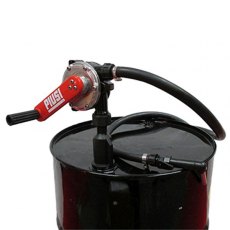Diesel Transfer Pumps Explained

A diesel transfer pump is a device used to transfer diesel fuel from one location to another. It is commonly used in various industries, such as agriculture, construction, transportation, manufacturing and on a domestic level by fuel suppliers and plumbers.
The diesel pump works by creating a vacuum or positive pressure to move the diesel fuel. It typically consists of an electric motor that drives an impeller or a piston, creating a suction force. The fuel is then drawn into the pump and discharged through an outlet hose or pipe. These pumps can either be electric or manual. Many fuel transfer pumps are 12 volt or 24 Volt and can be operated using a car battery for use anywhere without an electrical supply. Alternatively, there are hand operated diesel transfer pumps for transferring small volumes of fuel into containers. For transferring larger volumes of fuel, electric pumps such as the ones you find at petrol stations are used.
Because fuel tends to dissolve the gaskets and other materials used in water pumps, water pumps cannot be used to transfer diesel and diesel pumps cannot be used to transfer water. It is recommended that you use the correct pump for your application. There are also specific transfer pumps with liquids of high viscosities.
Our Diesel pumps come in difference voltages starting from 12v going all the way up to 400v with the most popular being 230v options.
Coming in a vast variety of shapes and fixing to suit all possible needs, you can get these pumps to mount drums, you can also retro fit the diesel pumps into existing dispensing set-ups or use these pumps for a completely new installation.
We also offer a range or self priming pumps for ease of use so you can go ahead and start to use the pumps right away.
Diesel transfer pumps also come in different flow rates ranging for around 56lpm (litres per minute) to 100lpm depending on how quickly you would like to dispensing (just bear in mind an average petrol station is 56lpm and anything higher could keep turning off the nozzle)
If you would like our advice on choosing the correct water or diesel pump, then please get in touch with our friendly team today.

Hand Fuel
Transfer Pump
230v Electric Fuel
Transfer Pumps
12V Electric Fuel
Transfer PumpsOur most popular diesel transfer pumps
Frequently Asked Questions
How does a fuel transfer pump work?
A fuel transfer pump works simple by pumping fuel such as diesel or kerosene from one tank or container to another. Some diesel transfer pumps are rotary vane pumps, others are gear pumps. Electric diesel transfer pumps can be purchased in 12 volt, 24 volt, 230 volt and in ac and dc versions. Some diesel transfer pumps can also be battery operated for remote use.
What is the best diesel transfer pump?
There are various types of diesel transfer pumps available depending on the application and the volume of fuel you are pumping. For large volumes of fuel, there are disel pumps integrated into fuel management systems so you can track your fuel consumption.
If you would like our advice on choosing the correct diesel pump, then please get in touch with our friendly team today.
For links to our fuel management systems please click Fuel Management Systems
What voltage do I need?
With a range of voltages this can become a little confusing when selecting your tank.
The 12v and 24v pumps tend to be used when mains power isn't available - an example of this will be farmers filling remotely in fields oppose to having to come back to the farm.
A 230v which is the most popular choice with our customers is a mains powered option and will work on a standard 3 pin UK plug. This option is mainly chosen with people who have constant access to power sockets.
The 400v option goes more into 3 phase which we suggest speaking to a qualified electrician to see if this is the voltage you require.
Is it safe to use a water pump to transfer fuel?
Because fuel tends to dissolve the gaskets and other materials used in water pumps, water pumps cannot be used to transfer diesel and diesel pumps cannot be used to transfer water. It is recommended that you use the correct pump for your application. There are also specific transfer pumps with liquids of high viscosities
Can I use a diesel pump to transfer petrol?
No, to transfer petrol you must use an ATEX rated pump which is safe to use in an explosive atmosphere. There are strict guidelines that must be followed in an areas where flamible substances are stored.
To learn more about the ATEX Directives go to the HSE's website here
One of our Atex Rated Pumps is the Piusi EX100 Fuel Transfer ATEX Pump

Piusi Panther Transfer Pump Accessories
Compatibility Guide
Diesel Tanks
A Guide
Frequently Asked Questions
Pumps
Fuel Pumps
How Does a Fuel Transfer Pump Work?
A fuel transfer pump works simple by pumping fuel such as diesel or kerosene from one tank or container to another. Some diesel transfer pumps are rotary vane pumps, others are gear pumps. Electric diesel transfer pumps can be purchased in 12 volt, 24 volt, 230 volt and in ac and dc versions. Some diesel transfer pumps can also be battery operated for remote use.
What is the Best Diesel Transfer Pump?
There are various types of diesel transfer pumps available depending on the application and the volume of fuel you are pumping. For large volumes of fuel, there are diesel pumps integrated into fuel management systems, so you can track your fuel consumption.
If you would like our advice on choosing the correct diesel pump, then please get in touch with our friendly team today.
For links to our fuel management systems please click Fuel Management Systems
Can I use a Diesel Pump to Transfer Petrol?
No, to transfer petrol you must use an ATEX rated pump which is safe to use in an explosive atmosphere. There are strict guidelines that must be followed in an areas where flamible substances are stored.
To learn more about the ATEX Directives go to the HSE's website here
One of our Atex Rated Pumps is the Piusi EX50 Atex Pump
If you want to learn more about these pumps, read our beginners guide to diesel pumps here.
What is the difference between 12V and 230V?
12v pumps tend to be more popular for people who are working more remote or on the travel where mains power isnt an option, These style of pumps come with 2 crocodile clips that attached onto a power source such as a car battery. 230V is more popular for use with static tanks in a working yard or a farm (for example). They tend to come with a 3 pin caravan plug or a 3 pin UK domestic plug.
What pump do I need?
With a large range of pumps we can offer it may be difficult to know where to begin. Because the pumps have different flow rates and this can impact your choice especially if you already have a nozzle or hose already on site. We recommend if you are unsure to give us a call on 01643704328 or email us on sales@fueltankshop.co.uk and we can assist you in your search.
What is the lead time for the pumps?
We try to keep our lead times all up to date and in a ever changing industry with high demand we cant always guarantee that we have every pump in stock. If the website doesn’t advertise a lead time we suggest popping on to the online chat, giving us a call or email just to double check and we can advise of the currently lead time.
Where are fuel dispensing pumps typically used?
Fuel dispensing pumps are mainly installed on static fuel storage tanks. They can be purchased as a complete unit with a tank, or they can be retrofitted to existing tanks.
Typically, fuel transfer pumps are used in non-resale refuelling environments as it is not weights and measures approved. (If a weight and measure pump is needed, we ask for you to contact us or send us an email on sales@fueltankshop.co.uk so we can discuss your requirements).
The fuel dispensing pump is an ideal solution for the refuelling of fleets of vehicles, agricultural machinery as well as plant equipment.
Can I use diesel transfer pumps for kerosene?
Unfortunatly no. Kerosene has a lower flash point that diesel.
Because of this lower flash point there will be a greater chance of a spark resulting in ignition during the pumping phase.
**Please note: All kerosene, just like petrol must be ATEX approved, meeting they are certified as being safe for use in potentially flammable environments**
What types of pumps are suitable for diesel?
A hand fuel transfer pump can be used to move fuel from one container to another. Useful in many different industries, including automotive, industrial, and agricultural, hand fuel transfer pumps are designed to be lightweight and portable, making them ideal for use in remote locations or in areas where power is not available. They can be used for refuelling vehicles, boats, and other equipment.
If you’re working remotely or travelling to areas where there isn’t mains power, 12v pumps are a good option. These types of pumps come with two crocodile clips that you attach onto a power source such as a car battery. Our 230v diesel pumps are more popular for use with static tanks on a working farm, for example, and tend to come with a 3-pin caravan plug or a 3-pin UK domestic plug.
Our engine driven fuel transfer pumps are an efficient way to move fuel from one location to another. These pumps are powered by an electric motor and are generally used for transferring fuel from a storage tank to a vehicle or other equipment. Available in a range of sizes, they can be used for a variety of applications in agricultural, industrial, and commercial. Learn more about these products with our helpful guide to diesel pumps.
How long can a 12V pump run on a battery?
This will depend on several factors, including the type and size of the battery, the pump's motor efficiency, and the amount of fuel being transferred. A fully charged 12V pump should run for several hours. However, if you are transferring a large amount of fuel or using the pump for an extended period, the battery may run out of power more quickly. It helps to choose a high-quality battery with a high amp-hour rating. Additionally, you can reduce the strain on the battery by using a pump with a more efficient motor, or by using the pump intermittently rather than continuously. It is also important to monitor the battery's charge level and recharge it as needed. Some 12V pumps come with built-in battery monitors or low-voltage shut-off features to help prevent damage to the battery.
Can I use a 18v battery on a 12V pump?
It is not recommended to use an 18V battery on a 12V pump. This is because the voltage of the battery needs to match the voltage of the pump to ensure proper function and prevent damage to both the pump and the battery. When you use a battery with a higher voltage than the pump is designed for, the motor in the pump will spin faster than intended. This can cause excessive wear and tear on the motor, which can lead to overheating, damage to the pump's internal components, and even total failure of the pump. In some cases, a pump may have a voltage range that it can operate within, which could allow it to function with an 18V battery. However, it is always best to consult the manufacturer's instructions and specifications before using a battery with a different voltage than what is recommended.
How much should it cost to replace a fuel pump?
When you’re looking into replacing a fuel pump for your diesel system, the cost can vary depending on several factors. A fuel pump is an essential component designed to move diesel safely and efficiently from a tank to where it’s needed, whether that’s powering machinery or filling a vehicle. You might need a replacement if your current pump is failing, causing slow fuel flow or inconsistent performance, and opting for a new one from Fuel Tank Shop ensures you get a reliable product built for the job. The price you’ll pay depends on the type of fuel pump you choose—hand-operated versions are simpler and typically less expensive, while electric models, like 12v, 24v, or 230v fuel transfer pumps, offer more power and convenience but come with a higher cost due to their added functionality. Labour charges for installation can also play a part, especially if you’re not fitting it yourself, so it’s worth considering that alongside the pump’s price. Explore our range and find a fuel pump that fits your budget and requirements, with our team on hand to offer advice if you need it.

 Login
Login











